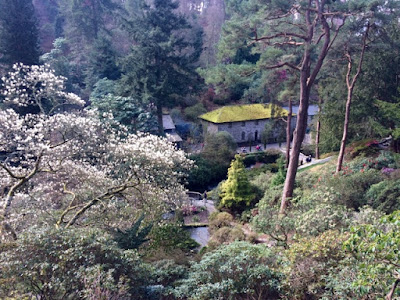Last weekend, I discovered a hidden gem in North Wales. It's as much a well-kept secret as it is a well-kept garden. Nestled on a tributary of the River Conwy near Tal-y-cafn, Bodnant must surely be one of Wales' largest and most pristine estates open to visitors.
Spring was in the air last weekend at Bodnant - and so too was a cloud of yellow daffodils, with brash golden trumpets held aloft on lemony petals. (Fun fact: scientists now reckon the trumpet of a daffodil is not related to the petals, but is a new organ, a corona, as found in Passiflora spp. (passion flower)).
The fields of yellow daffodils were an inspiration. They even inspired another visitor to don her own corona.
One of the most exciting things about Bodnant was its setting. You can visit gardens all over and many have stunning backdrops - from my own favourite, Lyme Park, you can see moorland and green rolling hills; but rarely will you find a hinterland quite so dramatic as the mountains of Snowdonia before Bodnant.
Another things I loved was that, in spite of the lateness of Spring, there was still plenty to see. Manicured roses were pruned and trained in vast swathes along the walls of the formal garden, (I hope) ready to charm visitors with heady aromas come Summer.
In fact, wherever I looked I found surprising beauty in kempt Winter-ready hibernating plants. The Wisteria, still not quite in bud in mid-April, wrought its twisting, gnarly form over the historic fountain (which I think they're hoping to restore this year).
In Manchester, even in April it feels like we're in the depths of Winter: I've found climate is the only guage for season and we're left distinguishing one type of rain from another. Here in Bodnant, however, the garden heralded Spring wherever you looked. Magnolias (ignorant of paint charts in back bedrooms) were in full bloom, and the rhodies were beginning to show their colour, too.
Of course, weathering all seasons, the lichens crept on...
And in the dell, Lysichiton americanus (American skunk cabbage) grew rampant amid the hue of fallen petals. It would give the impression of some romantic alien jungle (if it weren't for the occasional skunky smell!)
What struck me about Bodnant was the sheer scale. If Lyme Park seems big, Bodnant is huge! When the National Trust took over the 80 acre site, they opened only a fraction of this to visitors. Since then, over half has been made accessible - and staggeringly, this whole area is not just accessible, but preened and manicured.
I have a couple of dates in the diary to return to Bodnant, and am looking forward to seeing it develop through the year - watch this space!
















